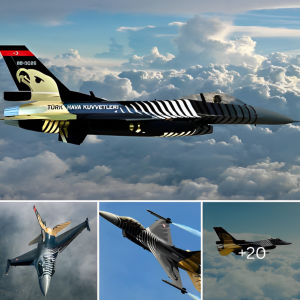It was a mammoth and speedy nuclear bomber. The XB-70A Valkyrie was the biggest airplane to fly MACH 3. The concept for the deep-penetration bomber emerged at the height of the Cold War in the 1950s as an option to replace the B-52. Developers wanted a delta-wing jet plane to outrun and outfox Soviet air defenses while flying at 70,000 feet. While not an overall success, this thing was robust with an intriguing story, including a fatal crash that I’ll recount below. So, let’s take a closer look at the XB-70A.

Crowd-Pleasing Size and Power
The Valkyrie wasn’t cheap at $700 million per prototype, and it never made it to full production. But this gargantuan airplane excited the 5,000 person crowd assembled to watch it take off for the first time in 1964. The overall size was particularly impressive at 196 feet long. The tail itself was 31 feet high. The airplane weighed 521,000 pounds. The XB-70A took six General Electric YJ93s with 30,000 pounds of thrust to achieve that high speed and ceiling.
There Were Downsides
The XB-70 program had problems though. It was determined that the airplane would have flown too straight and level to fool any surface-to-air missile. The XB-70A was going to be a fat target. The Soviets had also improved their air defenses during the airplane’s development. Even the John F. Kennedy administration knew that Intercontinental Ballistic Missiles were going to be cheaper and more effective than the XB-70A. Kennedy relegated the airplane to experimental status in 1961 due to budget cuts and shifting priorities.
Fatal Accident Seals Its Fate
Tragedy struck the program in 1966. A second Valkyrie, known as the XB-70A2 was flying 11 miles north of Barstow, California before it crashed into a NASA F-104N Starfighter and two people died. Bob Alvis of Aerotech News recounted the horrifying incident.
“MID-AIR MID-AIR MID-AIR!” The radio came alive with the frantic and dreaded call of planes and pilots in distress. The first to suffer was NASA chief test pilot Joe Walker in his F-104N, as it rolled inverted across the back of the XB-70. The F-104’s T-tail ripped at the Valkyrie’s drooped right wingtip and his errant craft rolled sharply left, out of control. It then flipped upside down and passed over the XB-70’s back, shearing off part of the right and most of its left vertical fins.”
The F-104 exploded in three seconds. Its pilot Joe Walker was killed. But the pilot and co-pilot of the Valkyrie kept flying the mammoth bomber and they didn’t know what hit them – they only heard a loud thump. They were not sure who made the distress call. They didn’t think it had anything to do with their airplane.
Alvis Continued the Story
“That all changed when the XB-70 shuddered and rolled over on its back, nose down, and went into a violent yaw, due to the fact that it no longer had sufficient vertical stabilizer area to hold it straight and level. It was at this point that both pilots knew their ship was doomed.”

The futuristic XB-70A was originally conceived in the 1950s as a high-altitude, nuclear strike bomber that could fly at Mach 3 (three times the speed of sound) — any potential enemy would have been unable to defend against such a bomber.

In this view the #1 XB-70A (62-0001) is in a level cruise flight mode at a relative high altitude judging from the darkness of the sky. The XB-70A, capable of flying three times the speed of sound, was the world’s largest experimental aircraft in the 1960s. Two XB-70A aircraft were built. Ship #1 was flown by the NASA Flight Research Center (now NASA Dryden), Edwards, California, in a high speed research program.
After 60 seconds, XB-70 pilot Al White was able to punch out and later survive but co-pilot Carl Cross didn’t make it. The tragedy had Al White recalling that those seconds felt like forever. White recounted the whole story in detail and told it to radio stations and podcasters over the years.
Paved the Way for Supersonic Civilian Flight
The XB-70A program was cancelled in 1969. But it gave the Air Force and NASA significant data on flying such a huge airplane at high speeds and altitude. The XB-70A was thus a partial success in that it provided the precursor to the Concorde SST that made its first flight in 1969. That airplane could cross the Atlantic in 3.5 hours. Meanwhile, the XB-70A was sent to the National Museum of the U.S. Air Force in Dayton, Ohio.








